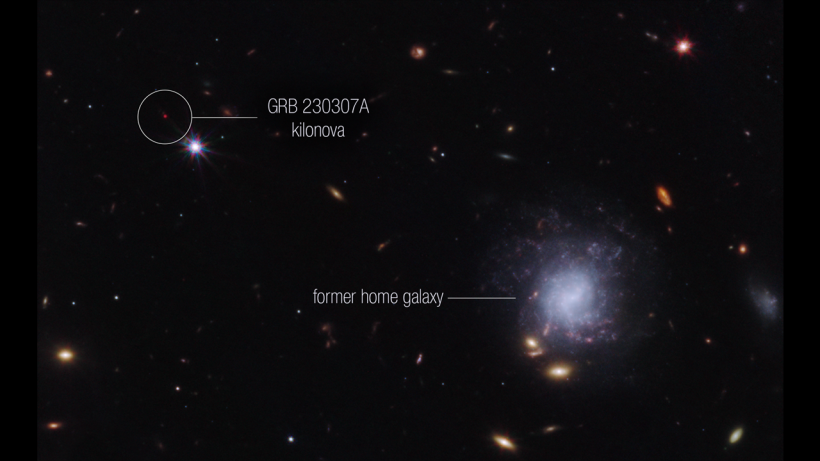NASA's James Webb Space Telescope has made a historic discovery by detecting a heavy element resulting from the merger of two neutron stars.
This revelation sheds light on the elusive processes behind the formation of crucial chemical elements in the cosmos, some of which hold immense value and are fundamental to life as we comprehend it.
NASA's James Webb Space Telescope Detects Second Brightest Gamma-Ray Burst
This high-energy event was a gamma-ray burst, GRB 230307A, ranked second brightest ever recorded. It is strongly believed to be the aftermath of the collision between two neutron stars, an occurrence known as a kilonova.
The James Webb Space Telescope, renowned for its extraordinary sensitivity, succeeded in capturing the initial mid-infrared spectrum of this kilonova, providing a direct glimpse into an individual heavy element born from such a cataclysmic event.

A collaborative effort involving various space and ground-based observatories, including NASA's Fermi Gamma-ray Space Telescope and Neil Gehrels Swift Observatory, facilitated observing and identifying the neutron star merger that culminated in the gamma-ray burst.
The James Webb Space Telescope also played a crucial role in the detection of tellurium, a chemical element, in the aftermath of the explosion.
Neutron star mergers, long thought to be crucibles for heavy element formation, have lacked tangible proof. Kilonovas and their rare aftermath pose a challenging observation.
Unlike short-lived gamma-ray bursts associated with massive star deaths, kilonovas are distinct, often enduring for minutes. GRB 230307A, a standout case, was detected by Fermi in March.
It ranked as the second brightest gamma-ray burst in over half a century, shining a thousand times brighter than the norm. It endured for 200 seconds, aligning it with long-duration gamma-ray bursts despite its unique origin.
As the explosion unfolded, multi-wavelength observations revealed pivotal kilonova features: rapid evolution and reddening of the optical/infrared counterpart. These characteristics are distinctive hallmarks of a kilonova.
Read Also: NASA's James Webb Space Telescope Finds Carbon Dioxide on Jupiter's Moon Europa
Rapid Explosion
Om Sharan Salafia, a co-author of the study at the INAF-Brera Astronomical Observatory in Italy, explained, "This type of explosion is very rapid, with the material in the explosion also expanding swiftly. As the whole cloud expands, the material cools off quickly and the peak of its light becomes visible in infrared, and becomes redder on timescales of days to weeks."
In the explosion's aftermath, Webb also helped astronomers detect the chemical element tellurium. Webb's NIRCam and NIRSpec instruments unveiled a spectrum indicating high-speed ejections with a distinctive tellurium emission - an element rarer than platinum on Earth.
Webb's infrared prowess pinpointed the neutron stars' location: a spiral galaxy 120,000 light-years from the merger. With growing collaboration between space and ground telescopes, more kilonovas are anticipated.
Webb's extended reach and the forthcoming Nancy Grace Roman Space Telescope's wide field of view promise further insights into these cosmic events' frequency and locales.
Ben Gompertz, a co-author of the study at the University of Birmingham in the UK, reflected on the transformative potential of Webb's capabilities.
He said, "Webb provides a phenomenal boost and may find even heavier elements. As we get more frequent observations, the models will improve and the spectrum may evolve more in time. Webb has certainly opened the door to do a lot more, and its abilities will be completely transformative for our understanding of the universe."
The findings of the team were published in the journal Nature.
Related Article: NASA Telescopes Unveil Striking Eagle Nebula Brimming with X-ray Hot Stars









